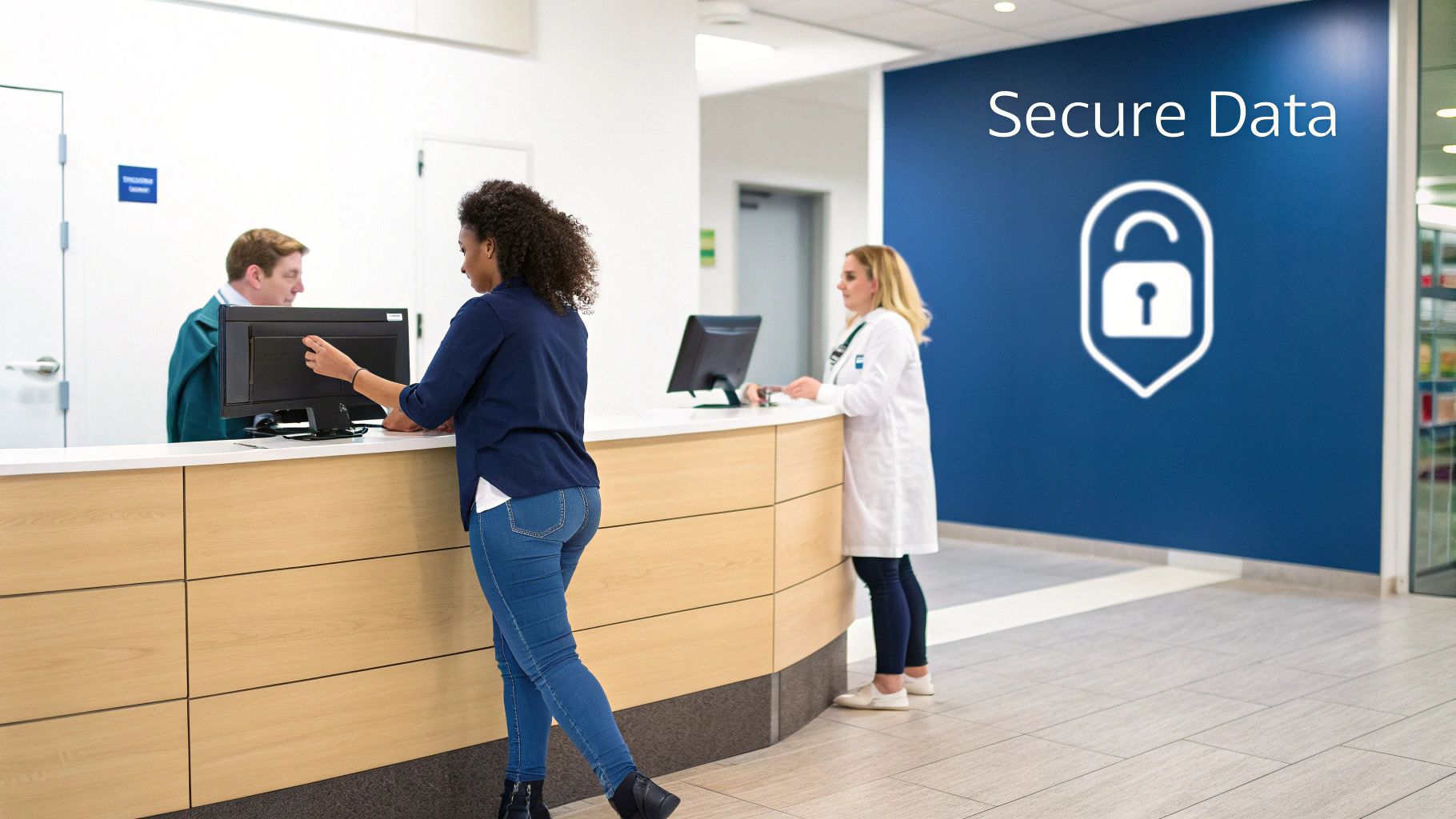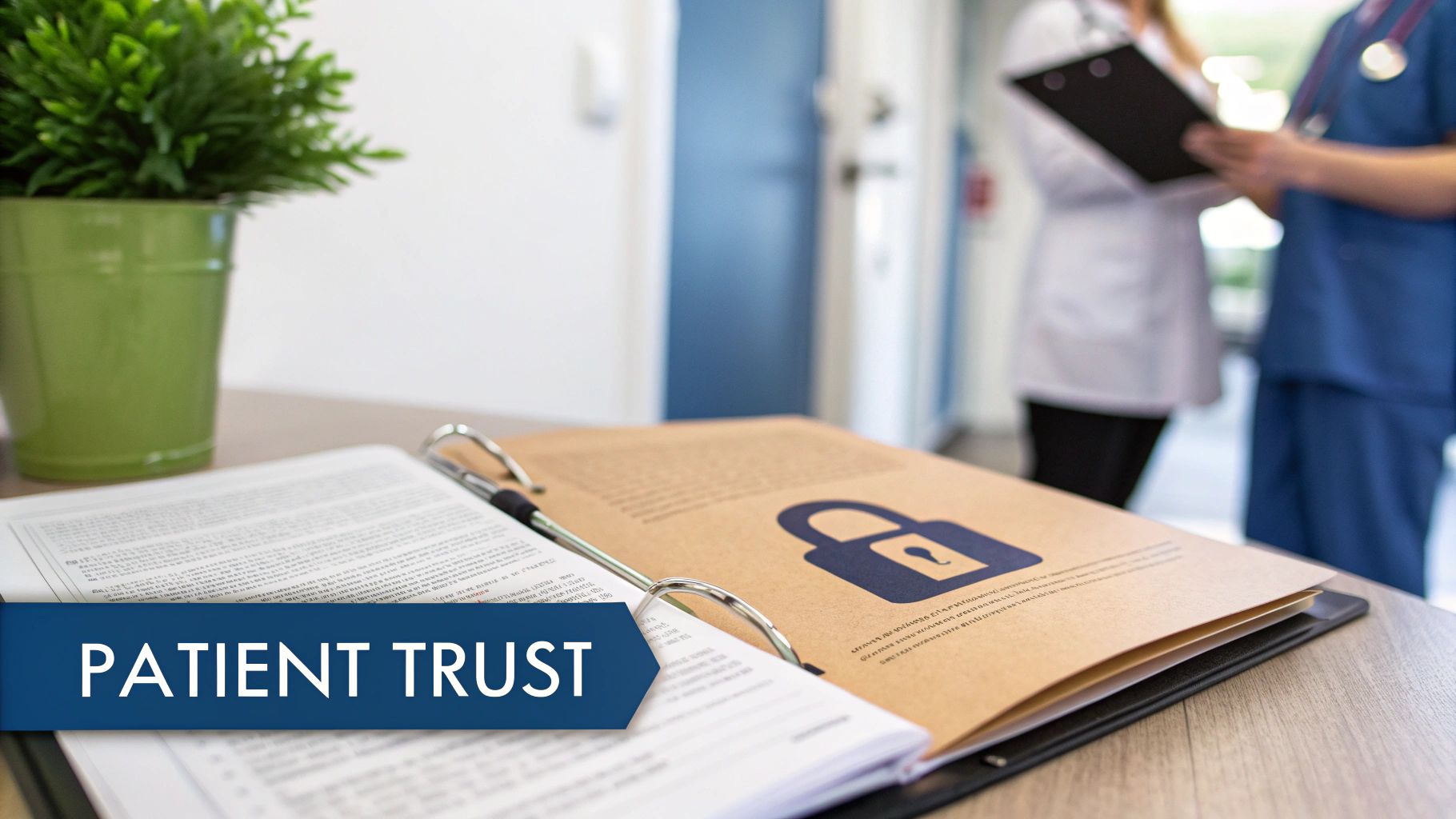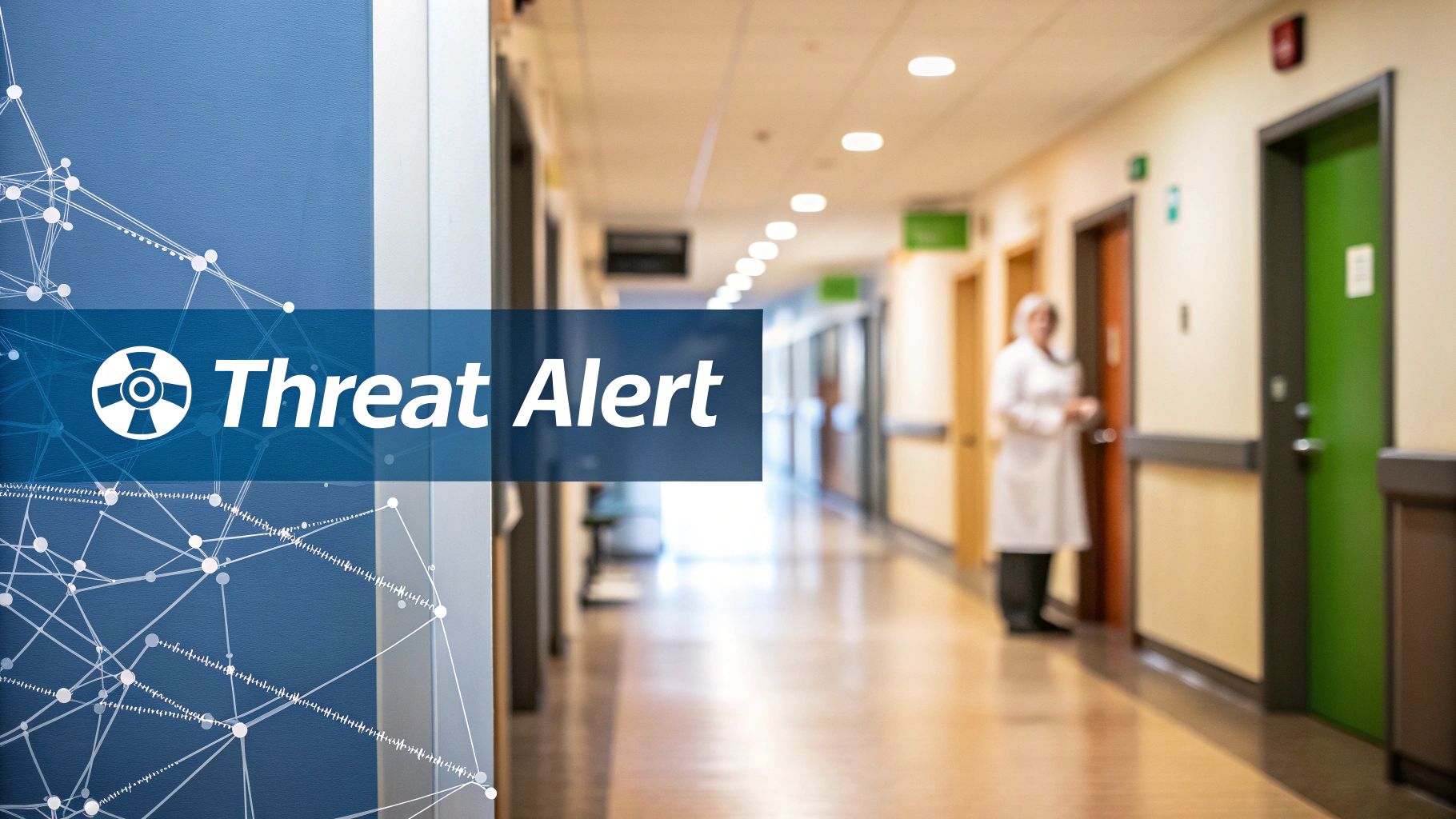Essential Data Security in Healthcare Tips
The Rising Threat Landscape in Healthcare Data

The healthcare industry, responsible for safeguarding sensitive patient data, faces an increasingly complex threat landscape. Cyberattacks targeting this sector have become more frequent and impactful, surpassing many other industries. The high value of medical records on the dark web makes healthcare a prime target for these attacks. Combined with the often outdated IT infrastructure found in many healthcare organizations, this creates a significant risk of data breaches.
Why Healthcare Data Is So Valuable to Cybercriminals
Medical records are a goldmine for cybercriminals. They contain Personally Identifiable Information (PII) such as names and addresses, as well as social security numbers, detailed health histories, and insurance information. This comprehensive data allows attackers to engage in identity theft, medical fraud, and even blackmail. For instance, criminals might use stolen data to file fraudulent insurance claims or obtain prescription drugs. The financial incentives are substantial: medical records can command up to 10 times the price of credit card numbers on the black market.
The Vulnerability of Healthcare Organizations
Many healthcare organizations struggle to stay ahead of evolving cyber threats. Outdated systems, limited security budgets, and the need to prioritize patient care can create vulnerabilities. The requirement for quick access and sharing of sensitive data can sometimes necessitate bypassing security measures, further increasing the risk. This creates opportunities for attackers to exploit weaknesses and access confidential patient information.
This isn't a new problem. Between 2005 and 2019, the healthcare sector experienced a large number of data breaches, representing 61.55% of all reported incidents globally. A significant number of these were due to hacking, demonstrating the increasing sophistication of cybercriminals. For more information, explore this topic further. This vulnerability is not just technological; it’s also human. Employees, often overworked and lacking sufficient cybersecurity training, can inadvertently create vulnerabilities by clicking phishing links or mishandling sensitive data.
The Impact of Data Breaches in Healthcare
The repercussions of a healthcare data breach extend far beyond financial loss. The impact can be devastating for patient trust, organizational reputation, and even the quality of patient care. Developing a robust breach response plan is therefore essential. Learn more with our guide on creating an effective data breach response plan. Data breaches can disrupt operations, compromise patient safety, and lead to costly litigation. The emotional distress experienced by patients whose private information is exposed adds another layer of complexity to the issue. Robust data security in healthcare is not just a best practice; it's a critical necessity.
Navigating the HIPAA Maze: Practical Compliance Approaches

Protecting patient data is paramount in healthcare. Successfully securing this sensitive information requires a deep understanding of the Health Insurance Portability and Accountability Act (HIPAA). This section breaks down HIPAA's complexities into practical data security measures, moving beyond legal jargon to focus on actionable strategies. We’ll explore how successful compliance officers build programs that truly enhance data security.
Risk Assessment in Real Clinical Environments
Effective data security starts with a comprehensive risk assessment. This means identifying potential vulnerabilities within your systems and processes. Think of it as a diagnostic process: you need to pinpoint weaknesses before developing a treatment plan. A practical risk assessment examines not only your IT infrastructure, but also physical security, administrative procedures, and staff training.
For example, a clinic might identify unauthorized physical record access as a high-risk area. This allows them to implement targeted measures, such as robust access control systems and comprehensive security awareness training. Addressing specific vulnerabilities strengthens the overall security posture.
Developing Effective HIPAA Policies
After identifying vulnerabilities, the next step is developing policies and procedures to mitigate them. This involves creating clear guidelines for staff on handling patient data, including access, storage, and disposal. These policies should be straightforward, easy to follow, and tailored to the realities of busy clinical settings.
However, true compliance goes beyond policy creation; it requires cultivating a culture of security awareness. Regular staff training, clear communication, and accountability systems are essential. Learn more in our article about HIPAA compliance requirements. This proactive approach is key to fostering a secure environment.
To further clarify the key requirements under the HIPAA Security Rule, the following table provides a detailed breakdown:
HIPAA Security Rule Key Requirements A breakdown of the essential requirements healthcare organizations must follow under the HIPAA Security Rule
| Requirement Category | Specific Requirements | Implementation Examples |
|---|---|---|
| Administrative Safeguards | Security Management Process | Conducting risk assessments, implementing security policies and procedures. |
| Assigned Security Responsibility | Designating a security officer responsible for overseeing the HIPAA security program. | |
| Workforce Security | Implementing procedures for authorizing and supervising workforce members' access to ePHI. | |
| Information Access Management | Implementing access controls to limit access to ePHI to only those who need it. | |
| Security Awareness and Training | Educating workforce members about HIPAA security policies and procedures. | |
| Security Incident Procedures | Establishing procedures for identifying, reporting, and responding to security incidents. | |
| Contingency Plan | Developing and testing a plan for ensuring the availability of ePHI during emergencies. | |
| Evaluation | Regularly evaluating the effectiveness of the security program. | |
| Physical Safeguards | Facility Access Controls | Implementing physical access controls to limit access to facilities where ePHI is stored. |
| Workstation Use | Implementing policies and procedures for the use of workstations that access ePHI. | |
| Workstation Security | Implementing physical safeguards to protect workstations from unauthorized access. | |
| Device and Media Controls | Implementing policies and procedures for the movement of hardware and electronic media containing ePHI. | |
| Technical Safeguards | Access Control | Implementing technical policies and procedures for electronic information systems that maintain electronic protected health information. |
| Audit Controls | Implementing hardware, software, and/or procedural mechanisms that record and examine activity in information systems that contain or use ePHI. | |
| Integrity | Implementing policies and procedures to protect electronic protected health information from improper alteration or destruction. | |
| Person or Entity Authentication | Implementing procedures to verify that persons or entities seeking access to electronic protected health information are who they claim to be. | |
| Transmission Security | Implementing technical security measures to guard against unauthorized access to electronic protected health information that is being transmitted over an electronic communications network. |
This table highlights the comprehensive nature of the HIPAA Security Rule, emphasizing the need for a multifaceted approach to data security. Implementing these safeguards is crucial for protecting patient information and maintaining compliance.
Documenting Compliance Efforts Efficiently
HIPAA mandates thorough documentation of compliance activities. While this can seem burdensome, efficient documentation doesn’t require mountains of paperwork. Focus on streamlined systems that are easy to maintain and audit. Automated tools, for instance, can track security incidents and staff training, significantly reducing administrative overhead.
Well-documented compliance also demonstrates your commitment to data security, providing crucial protection in case of a breach or audit. This proactive approach is not simply about checking boxes; it's about building a culture of data security within your organization, fostering trust and ensuring patient information remains protected.
Modern Threats Targeting Your Patient Data

Building on the foundational principles of data security is crucial for addressing the advanced threats targeting patient data. These threats exploit vulnerabilities within the healthcare system, requiring specialized defenses and proactive strategies. While basic security measures are important, they often fall short against sophisticated cybercriminal tactics. Healthcare organizations must be prepared for these unique challenges.
The Rise of Ransomware in Healthcare
Ransomware attacks have become a significant threat to healthcare. These attacks encrypt critical data, holding it hostage until a ransom is paid. This not only threatens data integrity but also patient safety. Targeting critical systems like medical devices or Electronic Health Records (EHRs) can cause life-threatening treatment delays. Furthermore, ransomware gangs are increasingly exfiltrating sensitive data before encryption. This double extortion tactic puts immense pressure on healthcare facilities, forcing them to choose between paying the ransom or risking the public release of confidential patient information.
The Insider Threat: A Persistent Danger
Data security threats in healthcare can also originate internally. Insider threats, whether accidental or malicious, represent a significant vulnerability. Accidental data exposure can occur through negligence, such as misplacing a laptop or sending an email to the wrong recipient. Malicious misuse of data by disgruntled or compromised employees is another serious risk. Detecting insider threats requires vigilance and proactive measures, such as access controls, activity monitoring, and regular security awareness training. You can find more information on protecting sensitive information in our guide.
Phishing Campaigns: Exploiting Healthcare Workflows
Phishing attacks remain a widespread problem in healthcare. These attacks use deceptive emails or messages to trick individuals into revealing sensitive information or clicking malicious links. Modern phishing campaigns are increasingly sophisticated, exploiting specific healthcare workflows and pressures. For example, a phishing email might impersonate a hospital administrator requesting urgent access to patient records. This targeted approach makes attacks more likely to succeed.
Third-Party Vendors: The Weakest Link?
Healthcare organizations rely on third-party vendors for various services, from IT support to billing and equipment maintenance. These vendors often have access to sensitive patient data, creating a security risk. Unfortunately, third-party vendors can be the weakest link in the security chain, potentially lacking the same level of security as the healthcare organization itself.
To understand the various threats, let's look at the following comparison:
Healthcare Cybersecurity Threat Comparison: This table compares different cybersecurity threats facing healthcare organizations by frequency, impact, and mitigation difficulty.
| Threat Type | Frequency | Potential Impact | Mitigation Difficulty | Trend |
|---|---|---|---|---|
| Ransomware | High | Critical - System disruption, financial loss, reputational damage | High - Requires advanced security measures and incident response plans | Increasing |
| Insider Threat | Moderate | High - Data breaches, financial loss, reputational damage | Moderate - Requires robust access controls, monitoring, and training | Consistent |
| Phishing | High | Moderate to High - Data breaches, malware infections, financial loss | Moderate - Requires user education, email security solutions, and multi-factor authentication | Increasing sophistication |
| Third-Party Vendor Risk | Moderate | High - Data breaches, compliance violations, reputational damage | Moderate - Requires strict vendor management programs and security assessments | Increasing due to reliance on external services |
Key Insights: As the table illustrates, ransomware and phishing are high-frequency threats with potentially critical impacts. While insider threats and third-party vendor risks may be less frequent, they still pose significant dangers. Mitigating these threats requires a multi-layered approach, addressing both technical vulnerabilities and human factors.
In 2023, healthcare data breaches continued to rise in the United States, with 725 breaches reported, exposing over 133 million individual records. Ransomware attacks contributed to worsened medical outcomes in 36% of healthcare facilities, while negligent employees contributed to 61% of data breach threats. More detailed statistics can be found here. This highlights the urgent need for comprehensive security measures in healthcare, extending beyond internal systems to address vulnerabilities posed by external partners. Implementing strict vendor management programs, including thorough security assessments and contractual obligations, is essential.
Technology Solutions That Actually Protect Patient Data

Protecting patient data is paramount in healthcare. It requires a proactive strategy that goes beyond simple regulatory compliance. Effective technology solutions are crucial for safeguarding sensitive information. Let's explore some key technologies that enhance data security in healthcare.
Encryption: Safeguarding Data at Rest and in Transit
Encryption is a foundational security measure. It converts readable data into an unreadable format, protecting it both during storage (data at rest) and transmission (data in transit). Think of it as a digital lock and key system for your sensitive information.
Encrypting patient records stored on a server, for example, prevents unauthorized access even if the server is compromised. Encrypting data sent between a doctor's office and a hospital safeguards it from interception. The specific encryption method chosen depends on the organization's unique needs.
Multi-Factor Authentication: Strengthening Access Security
Multi-Factor Authentication (MFA) adds an extra layer of protection. It requires users to present multiple forms of identification to access sensitive data. This makes it significantly harder for unauthorized individuals to gain entry, even if they possess a stolen password.
MFA might involve entering a password and then confirming identity via a code sent to a mobile phone. Modern MFA solutions can be implemented without disrupting clinical workflows.
Access Control Systems: Balancing Security and Accessibility
Controlling data access is fundamental. Access control systems manage user permissions, ensuring that individuals can only view or modify information appropriate to their roles. A nurse might access a patient's medical chart, while a billing clerk would only access billing information.
This granular control is essential for protecting patient privacy. Effective access control systems balance security with the practicalities of a busy clinical environment. You might be interested in: How to master data protection strategies.
Cloud Security: Protecting Data in the Cloud
Cloud computing offers scalability and cost-effectiveness, leading many healthcare organizations to migrate their data. However, cloud security requires careful planning.
Choosing a reputable cloud provider with robust security measures is essential. Properly configuring access controls and encryption within the cloud environment is also vital. Data stored in the cloud should always be encrypted, and access should be strictly limited.
Security Monitoring Tools: Early Warning and Threat Detection
Security monitoring tools provide real-time insights into network activity. They alert administrators to potential threats, such as unauthorized access attempts or malware infections.
These tools detect suspicious patterns, allowing for rapid response and mitigation. Proper configuration is crucial. Tools must be fine-tuned to avoid overwhelming staff with false positives, ensuring that alerts focus on genuine threats. Implementing these technologies significantly strengthens data security in healthcare, safeguarding patient information and building trust.
Creating a Security-Minded Healthcare Culture
Protecting patient data isn't just about having the latest technology. It's about building a strong security culture throughout the entire healthcare organization. This means creating an environment where everyone, from doctors and nurses to administrative staff, understands the vital role of data security and actively participates in protecting it. Let's explore how successful healthcare organizations cultivate this kind of culture.
Building Effective Security Awareness Programs
Effective security awareness programs are more than just annual compliance training sessions. They actively engage clinical staff by focusing on their specific workflows and priorities. Consider the busy schedules of nurses and doctors who need quick, reliable access to patient information. Security measures that slow down this access can be seen as barriers to patient care.
Therefore, security awareness programs must seamlessly integrate security practices into existing workflows. For example, training might focus on spotting phishing emails disguised as urgent patient requests or on secure mobile device practices during home visits. This targeted training makes security more relevant and effective. Simulated phishing attacks and interactive exercises can further reinforce learning and engagement.
Creating Practical Security Policies
Security policies should be practical and applicable to the real-world demands of patient care. They need to be thorough, yet avoid unnecessary complexity that could hinder daily operations. The best approach is to focus on clear, concise guidelines that address common security risks.
It's important to acknowledge the need for immediate data access in critical situations. Security policies should accommodate these urgent needs while still emphasizing data protection. For instance, a policy might outline the procedure for emergency access to patient records, balancing speed with proper authentication and audit trails. Check out our guide on security awareness training topics for more in-depth information.
Implementing Incident Response Frameworks
A robust incident response framework is crucial for protecting both data and patients during a security event. This framework should provide clear steps for identifying, containing, and recovering from incidents. It should also include communication templates for various scenarios, ensuring everyone involved stays informed and coordinated.
For example, in a ransomware attack, the framework should detail procedures for isolating affected systems, preserving crucial evidence, and communicating effectively with both patients and regulatory bodies. Regular drills and simulations are also vital for testing the framework's effectiveness and making any necessary improvements.
Fostering Accountability Without Blame
Accountability is essential for security, but it shouldn’t foster a culture of blame. Effective accountability focuses on identifying systemic weaknesses and improving processes, not punishing individuals. This encourages staff to report security incidents without fear of reprisal, leading to faster response and mitigation.
This could involve establishing clear reporting channels for security incidents and providing feedback to staff on the outcomes of investigations. Transparent communication and a focus on continuous improvement help create a culture of shared responsibility for security.
Managing Change Effectively
Implementing new security measures can often be met with resistance. Effective change management strategies are key to minimizing disruptions and encouraging adoption. This includes involving staff early on, explaining the reasons behind the changes, and proactively addressing any concerns.
For example, when implementing multi-factor authentication, involving clinicians in selecting and testing the chosen solution can ensure the system is both secure and compatible with their workflows, making successful implementation more likely. By focusing on these key elements, healthcare organizations can build a security-conscious culture that truly safeguards patient data.
Securing the Mobile Healthcare Environment
As healthcare continues its transition beyond traditional hospital walls, safeguarding patient data in mobile environments is more critical than ever. From clinicians using tablets for patient records during rounds to patients utilizing wearable devices that transmit health information, the mobile healthcare landscape introduces specific data security challenges. This demands a modern approach to data protection, balancing flexibility and accessibility with robust security measures.
Mobile Device Management in Healthcare
Mobile Device Management (MDM) solutions are crucial for protecting the increasing number of mobile devices within healthcare. These tools empower organizations to control and monitor devices, implementing essential security policies such as password requirements and data encryption. This proactive approach helps prevent unauthorized access to sensitive information should a device be lost or stolen.
Leading healthcare providers are adopting MDM solutions designed to integrate seamlessly with clinician workflows. For instance, devices can be configured to automatically connect to secure Wi-Fi networks within the hospital, while simultaneously requiring VPN connections for remote access. This setup streamlines access while maintaining a high level of security.
Securing Telemedicine and Remote Access
Telemedicine has become a cornerstone of modern healthcare delivery, facilitating remote consultations and patient monitoring. Ensuring the security of these virtual interactions is paramount. Telemedicine platforms need strong security frameworks to protect patient privacy during video consultations and data transmission. This includes encrypting all communications and data, along with robust authentication measures for both patients and clinicians.
Secure remote access is another vital consideration. Clinicians working remotely need secure methods for accessing patient data and hospital systems. This often involves VPNs and multi-factor authentication to verify identity and safeguard data in transit.
Addressing the Security Challenges of Medical IoT
The Internet of Medical Things (IoMT), encompassing devices like wearable heart monitors and implanted insulin pumps, is revolutionizing patient care. While these devices generate valuable health data, they also introduce new security vulnerabilities. Data transmitted from these devices must be encrypted, and access to the devices themselves needs to be strictly controlled.
Regular security updates for IoMT devices are essential for addressing vulnerabilities and mitigating emerging threats. Healthcare organizations must develop comprehensive strategies for managing and securing this expanding network of connected medical devices.
Best Practices for Securing the Mobile Healthcare Environment
Here are some best practices for enhancing security in the mobile healthcare environment:
- Implement robust MDM solutions: Control and monitor all mobile devices accessing patient data.
- Enforce strong passwords and multi-factor authentication: Strengthen access control to prevent unauthorized system access.
- Encrypt data at rest and in transit: Protect patient information regardless of its location or transmission method.
- Secure telemedicine platforms: Ensure the protection of virtual consultations and data transmissions.
- Implement secure remote access strategies: Utilize VPNs and robust authentication for clinicians accessing systems remotely.
- Manage and secure IoMT devices: Encrypt data from IoMT devices and implement regular security updates.
- Provide regular security awareness training: Educate staff on best practices for mobile security.
By adopting these practices, healthcare organizations can safeguard sensitive patient data while leveraging the advantages of mobile technology.
Learn more about Whisperit and how it can benefit your healthcare organization.